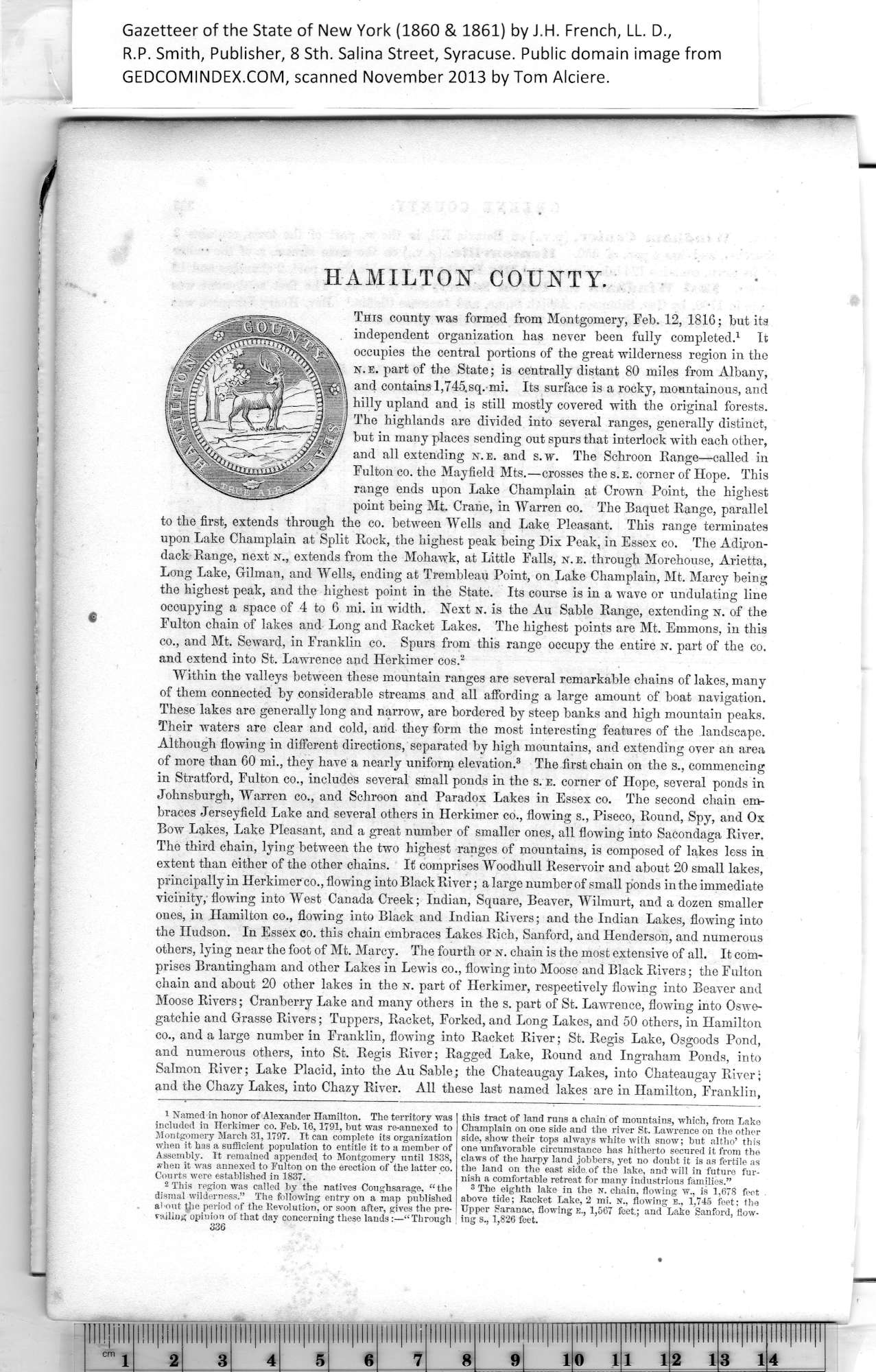|
HAMILTON COUNTY.
This county was formed from Montgomery, Feb. 12, 1816; but its
independent organization has never been fully completed.1 It
occupies the central portions of the great wilderness region in the
n. e. part of the State; is centrally distant 80 miles from Albany,
and contains 1,745.sq. mi. Its surface is a rocky, mountainous, and
hilly upland and is still mostly covered with the original forests.
The highlands are divided into several ranges, generally distinct,
but in many places sending out spurs that interlock with each other,
and all extending n.e. and s.w. The Schroon Range—called in
Fulton co. the Mayfield Mts.—crosses the s.e. corner of Hope. This
range ends upon Lake Champlain at Crown Point, the highest
point being Mt. Crane, in Warren co. The Baquet Range, parallel
to the first, extends through the co. between Wells and Lake Pleasant. This range terminates
upon Lake Champlain at Split Rock, the highest peak being Dix Peak, in Essex co. The Adiron¬
dack Range, next n., extends from the Mohawk, at Little Falls, n.e. through Morehouse, Arietta,
Long Lake, Gilman, and Wells, ending at Trembleau Point, on Lake Champlain, Mt. Marcy being
the highest peak, and the highest point in the State. Its course is in a wave or undulating line
occupying a space of 4 to 6 mi. in width. Next n. is the Au Sable Range, extending n. of the
Fulton chain of lakes and Long and Racket Lakes. The highest points are Mt. Emmons, in this
co., and Mt. Seward, in Franklin co. Spurs from this range occupy the entire n. part of the co.
and extend into St. Lawrence and Herkimer cos.2
Within the valleys between these mountain ranges are several remarkable chains of lakes, many
of them connected by considerable streams and all affording a large amount of boat navigation.
These lakes are generally long and narrow, are bordered by steep banks and high mountain peaks.
Their waters are clear and cold, and they form the most interesting features of the landscape.
Although flowing in different directions, separated by high mountains, and extending over an area
of more than 60 mi., they have a nearly uniform elevation.3 The first chain on the s., commencing
in Stratford, Fulton co., includes several small ponds in the s. e. corner of Hope, several ponds in
Johnsburgh, Warren co., and Schroon and Paradox Lakes in Essex co. The second chain em¬
braces Jerseyfield Lake and several others in Herkimer co., flowing s., Piseco, Round, Spy, and Ox
Bow Lakes, Lake Pleasant, and a great number of smaller ones, all flowing into Sacondaga River.
The third chain, lying between the two highest ranges of mountains, is composed of lakes less in
extent than either of the other chains. If comprises Woodhull Reservoir and about 20 small lakes,
principally in Herkimer co., flowing into Black River; a large number of small ponds in the immediate
vicinity,' flowing into West Canada Creek; Indian, Square, Beaver, Wilmurt, and a dozen smaller
ones, in Hamilton co., flowing into Black and Indian Rivers; and the Indian Lakes, flowing into
the Hudson. In Essex co. this chain embraces Lakes Rich, Sanford, and Henderson, and numerous
others, lying near the foot of Mt. Marcy. The fourth or n. chain is the most extensive of all. It com¬
prises Brantingham and other Lakes in Lewis co., flowing into Moose and Black Rivers; the Fulton
chain and about 20 other lakes in the n. part of Herkimer, respectively flowing into Beaver and
Moose Rivers; Cranberry Lake and many others in the s. part of St. Lawrence, flowing into Oswe¬
gatchie and Grasse Rivers; Tuppers, Racket, Forked, and Long Lakes, and 50 others, in Hamilton
co., and a large number in Franklin, flowing into Racket River; St. Regis Lake, Osgoods Pond,
and numerous others, into St. Regis River; Ragged Lake, Round and Ingraham Ponds, into
Salmon River; Lake Placid, into the Au Sable; the Chateaugay Lakes, into Chateaugay River;
and the Chazy Lakes, into Chazy River. All these last named lakes are in Hamilton, Franklin,
|
this tract of land runs a chain of mountains, which, from Lake
Champlain on one side and the river St. Lawrence on the other
side, show their tops always white with snow; but altho’ this
one unfavorable circumstance has hitherto secured it from the
claws of the harpy land jobbers, yet no doubt it is as fertile as
the land on the east side of the lake, and will in future fur¬
nish a comfortable retreat for many industrious families.”
2 The eighth lake in the N. chain, flowing W., is 1,678 feet
above tide; Racket Lake, 2 mi. n., flowing e., 1,745 feet; the
Upper Saranac, flowing e., 1,567 feet.; and Lake Sanford, flow¬
ing s., 1,826 feet. |
1
Named in honor of Alexander Hamilton. The territory was
included in Herkimer co. Feb. 16,1791, but was re-annexed to
Montgomery March 31, 1797. It can complete its organization
when it has a sufficient population to entitle it to a member of
Assembly. It remained appended to Montgomery until 1838,
when it was annexed to Fulton on the erection of the latter co.
Courts were established in 1837.
2
This region was called by the natives Coughsarage, “tlie
dismal wilderness.” The following entry on a map published
about the period of the Revolution, or soon after, gives the pre¬
vailing opinion of that day concerning these lands:—“Through
3
336
|
